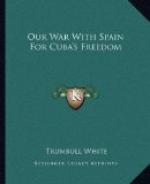General Merritt arrived in Manila bay on July 25, and after reporting to Admiral Dewey assumed command of the American troops in the Philippines. He lost no time in making himself familiar with the situation, and established headquarters at the Cavite arsenal.
The German fleet at Manila.
As soon as the American blockade of Manila was declared, Germany began to enlarge her fleet in those waters until all but three of the German men-of-war on the Asiatic station were either in Manila bay or its vicinity. The German naval officers took pains to show particular friendliness towards the Spaniards, as for example in saluting the Spanish flag at Manila on the arrival of every additional ship. The German officers visited the Spanish fortifications and trenches, and the Manila newspapers asserted that the presence before the city of so many German ships enabled the Spanish authorities and the people of Manila to regard the American fleet with complacency.
On June 27 the McCulloch met the Irene, one of the German fleet, at Corregidor island, preparing to enter the bay, and signaled to her: “We wish to communicate with you.” The Irene paid no attention to the signal, and proceeded on her way until a small boat was sent out to her from the McCulloch. The captain of the Irene explained the matter by saying that he had misunderstood the signal. The action of the Irene in interfering with the attack by the insurgent vessel, Filipinas, on the Spanish garrison at Isla Grande, in Subig bay, was in line with the attitude adopted by the German naval officers.
The Filipinas, a steamer of about 700 tons, loaded with a half cargo of tobacco, was in hiding in the coves around Subig bay. She was owned and officered by Spaniards, but her crew was a native one. The crew mutinied and killed the twelve officers. They then took charge of the ship and hoisted the insurgent flag. On the shore of Subig bay, and chiefly in the town of Subig, were 400 Spanish soldiers. As the insurgent forces on the land began to close in on them they fled in a body to the Isla de Grande, near the mouth of Subig bay, taking with them 100 sick and about 100 women. They retained their small arms and had only one Maxim gun. The insurgents hoped to starve them into submission. About this time the Filipinas incident occurred, whereby she passed from the Spanish to the insurgents. Two hundred insurgent soldiers took the ship and approached the island and fired on the Spaniards. Their firing was ineffective, but after awhile the Spaniards, probably realizing the ultimate hopelessness of their position, hoisted the white flag. At almost the same time the German cruiser approached from within the bay and the Spaniards hauled down the white flag, for they evidently had reason to hope for interference by the Germans. The German ship at once advanced to the Filipinas and said that the flag she flew was not recognized, and if it were not at once hauled down and a white one substituted she would be taken with her crew to Manila as prisoners. The Filipinas at once hauled down the insurgent flag, hoisted the white one and started immediately south to Manila bay. All this happened July 6. She arrived off the American flagship late in the evening and the insurgents at once reported the matter to the admiral.




